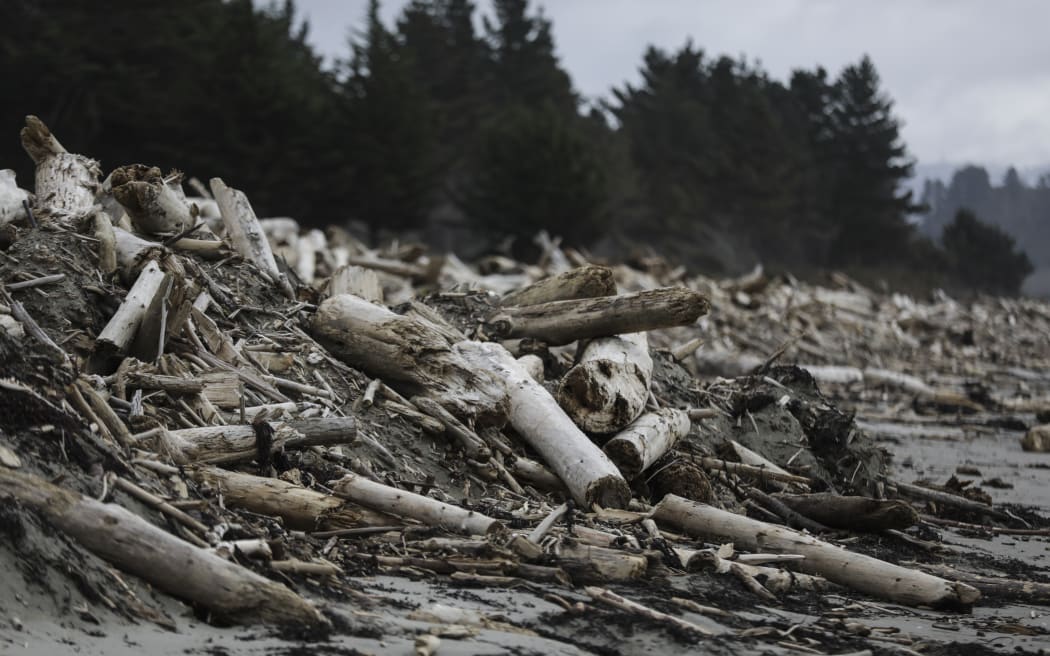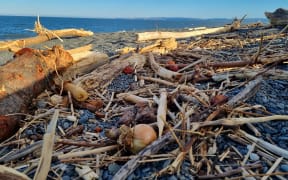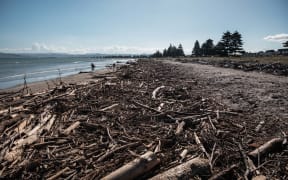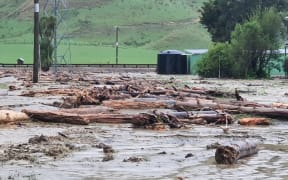
Slash piled up on a Gisborne beach. Photo: RNZ / Rebekah Parsons-King
The first changes to forestry regulations since Cyclone Gabrielle have been announced, including clear rules on harvesting practices and new requirements to remove slash from erosion-prone land.
The National Environmental Standards for Plantation Forestry (NES-PF) have been renamed the National Environmental Standards for Commercial Forestry (NES-CF), to reflect that the rules now include carbon forests deliberately established for commercial purposes, and set expectations for harvesters.
Announcing the changes on Tuesday, Forestry Minister Peeni Henare said slash regulations had been tightened to reduce the risk of damage to downstream communities, as had happened during Cyclone Gabrielle.

Forestry Minister Peeni Henare. Photo: RNZ / Samuel Rillstone
"Under the new regulations, slash longer than two metres, and with a large-end diameter of more than 10 centimetres, must be removed after harvesting from erosion-prone land unless it is unsafe to do so," he said in a statement.
"This is a minimum standard across the country, and councils can apply more stringent requirements if they choose."
"Where foresters are unable to meet these national standards, they will need to obtain resource consent, meaning councils consider the risks and impacts on a site-by site basis."
The new rules will take effect from 2 November.
Cyclone Gabrielle highlighted the need for better regulations on forestry, after woody debris was washed into waterways and caused widespread damage and flooding on the East Coast.
The Ministerial Inquiry into Land Use (MILU) was commissioned, and recommended changes such as an end to clear-felling, and better solutions for keeping slash out of waterways.
But work on these changes had begun earlier than the cyclone, with consultation being carried out in 2022.
Environment Minister David Parker said the new national standards would give councils greater control over commercial forestry, now able to have rules in their plans controlling where new commercial forests were located.

Environment Minister David Parker. Photo: RNZ / David Parker
"There has been a big increase in carbon forests since the forestry regulations were introduced in 2018. Carbon foresters will now need to meet the same environmental standards as plantation foresters.
"There are also new provisions for managing wilding tree spread to help better control these species."
Environmental group welcomes the changes
The news was welcomed by Mana Taiao Tairāwhiti, a group which campaigned hard for the government to commission its ministerial inquiry.
Spokesperson Manu Caddie said rules which required harvesters to remove slash on erosion-prone land were exactly what they had been asking for.
"This is a great victory for people-power, and shows that when the people lead, the leaders will follow," he said.
"I've previously expressed my disappointment in the government's initial response to the Ministerial Land Use Inquiry, but this is what we were looking for and full credit must go to ministers David Parker and Peeni Henare for making these tangible improvements to the regulations."
"It is also good to see more controls over the risk of sediment leaving harvest sites - now we need to see similar rules applied to pasture on erosion-prone slopes."
New Zealand Forest Owners Association president Grant Dodson said there were parts of the new regulations it agreed with, and parts it did not.
"Three [key] changes - one we don't really support, which is the resource consenting."
Under the new regulations, landowners would need council consent to put forests on their land.
He said forestry presented an opportunity to build the country's wealth and fight climate change, and people should be able to make their own decisions about planting forests on their land.
"The slash changes, we reservedly see the need for that and will certainly work with that, and when it comes to the incorporation of permanent forest, that was an expected change."
He said it was too early to judge whether the changes would affect jobs or profits.
"We're going to have to do this anyway, either with or without the regulation, and most forestry companies are doing it, so yep, I think it's going to be workable."
Meanwhile, a normally pristine Hawke's Bay beach was still blanketed with slash following Cyclone Gabrielle, but there was no money to clean the wood debris away.
Waikare Beach was inundated with bits of logs and waste wood strewn kilometres up and down the beach making access difficult.
A Department of Conservation campground at the nearby river mouth was closed until further notice due to flooding and slips damage and the boat ramp was due to be demolished.
The regional Silt Recovery Taskforce said it has visited the beach several times and has a clean-up plan but no money for it.
Its woody debris manager Jamie Cox estimated it would cost in the millions to clear the slash along the coastline.
Cox told Checkpoint the Waikare Beach was severely inundated with debris, some up to 2m high.
The taskforce had found the best treatment was to put debris out of the waterline to the high tide mark and put it in stacks to stop any further mobilisation and allow for recreational use of the beach between the stacks.
Cox also favoured the idea of "high temperature incineration" to get rid of the slash.
"There's been a number of areas of inundation that we've been working through the priorities, and I suppose Waikare Beach is one of those that we haven't got to yet."
He said the beach was difficult to walk through, with "hills and small mountains" of debris covering it.






